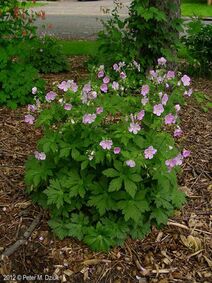Geranium maculatum
| Geranium maculatum | |
 | |
| Light: | |
| Moisture: | |
| Hardiness: | 5 |
| Soil pH: | 5.6-8.4 |
| Height: | 2' |
| Width: | 1' |
| Blooms: | Mid Spring-Mid Summer |
| Native to: | |
| Nectary | |
| Medicinal Rating: | |
| Tea: | Yes |
Geranium maculatum (common names: spotted cranesbill and wild geranium)
Wild geraniums are not the same as your chain box store varieties. These veined blossoms range from pink to magenta with white or dark purple sometimes occurring and they are a magnet for native bees searching for nectar. The petals lure bumblebees, mason bees, cuckoo bees, long-horned bees, and more as well as various types of butterflies. The plant prefers moist soil in light shade and can be found in abundant patches in the woods. Forming seeds are attached to the plant with a unique tail that bends and moves based on humidity. These tails catapult the seeds into the ground at distances of 20 to 30’ away. The plants do not bloom the first year but may bloom in the second year if strong enough.
Propagation: Seed - sow spring in a cold frame. When they are large enough to handle, prick the seedlings out into individual pots and plant them out in the summer.
Division in spring or autumn. Larger clumps can be replanted direct into their permanent positions, though it is best to pot up smaller clumps and grow them on in a cold frame until they are rooting well. Plant them out in the spring.
Cultivation: Succeeds in any moderately fertile retentive soil in a sunny position[1]. Tolerates a wide range of soil types[1], including water-logged soils[2].
Plants are hardy to about -25°c[2].
Members of this genus are rarely if ever troubled by browsing deer or rabbits[3].
Range: Eastern N. America - Maine to Georgia, west to Arkansas, Kansas and Manitoba.
Habitat: Wet places in woods, wet rocks and in swamps[2]. Woodlands, thickets and meadows[4].
Medicinal: The whole plant, but especially the root, is antiseptic, highly astringent, diuretic, styptic and tonic[5][6][7][8][9][10]. An infusion of the whole plant, or of the roots alone, is used in the treatment of diarrhoea (especially in children and the elderly), dysentery, irritable bowel syndrome, cholera, kidney complaints, bleeding and a wide range of other ailments[11][12][13]. It is often used in combination with other herbs[10]. Externally, it is applied to purulent wounds, haemorrhoids, thrush, vaginal discharges and inflammations of the mouth[10]. The plants are rich in tannin[12], the root containing 10 - 20%[9].
The roots can be harvested in the autumn then dried and stored[12]. It is best to harvest the roots as the plant comes into flower since it is then at its most active medicinally[5]. The leaves are harvested as the plant comes into flower and are dried for later use[10].
Usage: A brown dye is obtained from the flowers[14].
The roots and the leaves are rich in tannin[5].
Plants are suitable for ground cover when spaced about 45cm apart each way[15].
Pollinators: Insects
Soil: Can grow in light, medium, and heavy soils.
Flower Type: Hermaphrodite
Links
References
- ↑ 1.0 1.1 Huxley, Anthony. The New Royal Horticultural Society Dictionary of Gardening. MacMillan Press, 1992.
- ↑ 2.0 2.1 2.2 Phillips, Roger and Martyn Rix. Perennials - The Definitve Reference. Pan Books, 1991.
- ↑ Thomas, Graham. Perennial Garden Plants. J. M. Dent & Sons, 1990.
- ↑ Lyndon, Merritt. Gray's Manual of Botany. American Book Co, 1950.
- ↑ 5.0 5.1 5.2 Grieve, Margaret. A Modern Herbal. Penguin, 1984.
- ↑ Lust, John. The Herb Book. Bantam Books, 1983.
- ↑ Kavasch, Barrie. Native Harvests. Vintage Books, 1979.
- ↑ Mills, Simon. The Dictionary of Modern Herbalism.
- ↑ 9.0 9.1 Foster, Steven and Billy Tatum. Medicinal Plants of Eastern and Central North America. Houghton Mifflin, 1990.
- ↑ 10.0 10.1 10.2 10.3 Bown, Deni. Royal Horticultural Society Encyclopaedia of Herbs and Their Uses. Dorling Kindersley, 1995.
- ↑ Usher, George. A Dictionary of Plants Used by Man. Constable, 1974.
- ↑ 12.0 12.1 12.2 Weiner, Michael. Earth Medicine, Earth Food. Ballantine Books, 1980.
- ↑ Chevallier, Andrew. The Encyclopedia of Medicinal Plants. Dorling Kindersley, 1996.
- ↑ Grae, Ida. Nature's Colors. MacMillan Publishing, 1974.
- ↑ Thomas, Graham. Plants for Ground Cover. Everyman, 1990.